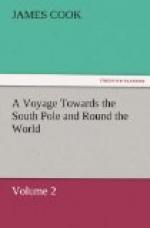We found it uninhabited, and were undoubtedly the first that ever set foot on it. We observed many trees and plants common at New Zealand; and, in particular, the flax-plant, which is rather more luxuriant here than in any part of that country; but the chief produce is a sort of spruce-pine, which grows in great abundance, and to a large size, many of the trees being as thick, breast high, as two men could fathom, and exceedingly straight and tall. This pine is a sort between that which grows in New Zealand, and that in New Caledonia; the foliage differing something from both, and the wood not so heavy as the former, nor so light and close-grained as the latter. It is a good deal like the Quebec pine. For about two hundred yards from the shore, the ground is covered so thick with shrubs and plants, as hardly to be penetrated farther inland. The woods were perfectly clear and free from underwood, and the soil seemed rich and deep.
We found the same kind of pigeons, parrots, and parroquets as in New Zealand, rails, and some small birds. The sea-fowl are, white boobies, gulls, tern, etc. which breed undisturbed on the shores, and in the cliffs of the rocks.
On the isle is fresh water; and cabbage-palm, wood-sorrel, sow-thistle, and samphire, abounding in some places on the shore, we brought on board as much of each sort as the time we had to gather them would admit. These cabbage-trees or palms were not thicker than a man’s leg, and from ten to twenty feet high. They are of the same genus with the cocoa-nut tree; like it they have large pinnated leaves, and are the same as the second sort found in the northern parts of New South Wales*. The cabbage is, properly speaking, the bud of the tree; each tree producing but one cabbage, which is at the crown, where the leaves spring out, and is inclosed in the stem. The cutting off the cabbage effectually destroys the tree; so that no more than one can be had from the same stem. The cocoa-nut tree, and some others of the palm kind, produce cabbage as well as these. This vegetable is not only wholesome, but exceedingly palatable, and proved the most agreeable repast we had for some time.
[Vide Hawkesworth’s Voyages, Vol III, Page 624.]
The coast does not want fish. While we were on shore, the people in the boats caught some which were excellent. I judged that it was high water at the full and change, about one o’clock; and that the tide rises and falls upon a perpendicular about four or five feet.
The approach of night brought us all on board, when we hoisted in the boats, and stretched to E.N.E. (with the wind at S.E.) till midnight, when we tacked, and spent the remainder of the night making short boards.




